Matador Network's Blog, page 166
May 21, 2024
What I Packed for a Few Laid-Back Days in Barcelona

On my first trip to Barcelona, I had a solid schedule for my three days in the city. Thanks to my Go City sightseeing pass, I had booked guided tours of La Sagrada Família and Park Güell, and a ride onboard the Montjuïc cable car. I also made plans to visit the atmospheric Gothic Quarter and try out the Teleférico del Puerto (the port cable car). When it came to choosing a place to stay, I randomly picked the tourist-free, laid-back neighborhood of El Poblenou. With a main pedestrian street full of cafes, bakery, restaurants, and local shops, as well as a beautiful beach, Playa de Bogatell, it was the perfect location to get back to at the end of a day filled with tourist crowds. Of course, having planned this trip meticulously, I packed my luggage with the same mindset. A bathing suit to enjoy the 85-degree weather on the beach, a comfortable and casual pair of shoes for the many miles I planned to walk every day, weather-appropriate and fun outfits that could work for both day and night, and a book that would immerse me into the city.
We hope you love the hotels and products we recommend! Just so you know, Matador may collect a small commission from the links on this page if you decide to book a stay or make a purchase. Listed prices are accurate as of the time of publication.
Where to stay in Barcelona’s El Poblenou Photo: Vio.com
Photo: Vio.com Photo: Vio.com
Photo: Vio.com Photo: Vio.comSee more photos
Photo: Vio.comSee more photosAt the northern end of El Poblenou, alongside the busy Avinguda Diagonal, Barcelona’s biggest avenue, is Meliá Barcelona Sky, a four-star ultra-modern hotel. The striking contemporary architecture of this luxury establishment, designed by renowned French architect Dominique Perrault, is only one of its many appeals. The sixth-floor pool, with its cabanas and loungers is a relaxing place to hang out, and so is the spa and the 24th-floor terrace from where you can get a bird’s eye view of the city. Book a room up high so you can wake up to vistas of the Mediterranean Sea. Meliá Barcelona Sky is 10 minutes on foot from the main pedestrian street of El Poblenou and less than 20 minutes to the beach.
Book Now from $297What I packed for a few days in BarcelonaPrimaDonna Swim MarivalView this post on InstagramA post shared by PrimaDonna Lingerie (@primadonnalingerie)
PrimaDonna is a lingerie brand that caters to all body types, with a very solid selection of swimwear and bras for women with busty, curvy bodies. The collections are always colorful and fun, with a variety of motifs and multiple versions of bikini bottoms and tops so that everyone can find the fit that works for them, no matter their size, preference, and comfort level.
Buy now from Glamuse from $231Suncloud Metric sunglassesView this post on InstagramA post shared by Suncloud Polarized Optics (@suncloudeyewear)
I dislike wearing sunglasses but you really can’t go without when visiting sunny Barcelona. This classic tortoise shell, polarized Metric frame from Suncloud works for all occasions and is comfortable, making wearing shades a lot less of a chore for those who don’t care for it. Because the Suncloud Metric is an affordable, plastic-frame model for everyday wear, I don’t feel particularly worried about scratching them or putting them back in their case after every single use.
Buy now from Amazon for $43.96Neutrogena Ultrasheer Dry Touch sunscreenView this post on InstagramA post shared by Neutrogena (@neutrogena)
I am extremely fair-skinned, with freckles all over, and a tendency to burn very quickly and very intensely, so there is no way I can be out in the Spanish sun without protection. Neutrogena’s Ultrasheer Dry Touch sunscreen is the only sunscreen that does not leave me shiny and with white streaks. It’s light, very fast absorbing, and leaves a matte, transparent finish so you can wear it all over your body and face without feeling sticky and gross. Just remember to apply every two hours for the best skin protection.
Buy now from Amazon for $8.88Pismo casual sneaker by VionicView this post on InstagramA post shared by Vionic Shoes Canada (@vioniccanada)
If you’re going to explore a city like Barcelona where the weather is hot on foot, forget the sandals and opt for a low-rise, casual sneaker like Vionic’s Pismo. You can walk many miles in them without discomfort thanks to their arch-support insoles and they still look good with a simple dress, a pair of shorts, or jeans. The Pismo sneaker comes in a variety of colors and motifs so you can make them match all your outfits. I own two pairs: one with a strawberry pattern and one plain navy blue, and I would not trade them for any other shoes. Also, when they get too dirty, you can throw them in the washing machine on a cold cycle (without the insoles) and they come out looking brand new.
Buy now from Amazon from $44.98The Shadow of the Wind by Carlos Ruiz ZafónView this post on InstagramA post shared by Carlos Ruiz Zafón (@zafonoficial)
The Shadow of the Wind, or La Sombra del Viento in Spanish, is a work of Gothic fiction that takes place in Barcelona. Written by late Carlos Ruiz Zafón, himself born in Barcelona, the story is a dark thriller with some elements of magic, that is sure to suck you right in and make your spine tingle. Take it with you to the Gothic Quarter and try to match the real-life locations to those in the novel. And if you like this one, there are four more that follow in the same vein — although they can all be read independently.
Buy Now from Amazon for $9.99Marie Dress from Lucas du TertreView this post on InstagramA post shared by Lucas du Tertre (@lucasdutertre.paris)
For a casual, yet elegant look, I opted for a knee-length button-down shirt dress from Parisian brand Lucas du Tertre. Made of 100 percent light cotton, with short sleeves, this dress is extremely comfortable for all body types, especially in hot weather. Both the blue gingham and the red stripes versions are equally beautiful and easy to wear.
Buy Now from Lucas du Tertre for $119.38Wallaroo hatView this post on InstagramA post shared by Wallaroo Hat Company (@wallaroohats)
Much like you need to protect your eyes with sunglasses and your skin with sunscreen, you need to protect your scalp with a hat. The Australia-based Wallaroo Hat Company makes UPF-fabric hats in a huge variety of models to suit everyone’s style. I travel with the stylish and packable Sedona Fedora in white, made of UPF-50, lightweight fabric. It has a long brim to shield your face and an inner drawstring to adjust for a perfect fit. 
This Stainless Steel Straw Allows Me To Drink Tap Water Anywhere in the World

I added something to my well-established travel setup this month – the LifeStraw Sip, the newest product from water filtration brand LifeStraw, available now for $34.95. As a travel editor, I’ve long been a fan of the brand’s filtration straws and bottles, formerly carrying a Go Series water bottle with me to filter water on the move. I now carry the Sip with me instead for two reasons: it allows me to carry a larger water bottle, and it’s even more effective at filtering. I’m now confident I can drink the water anywhere in the world without having to buy bottled water, simply because I carry this one straw with me at all times.
We hope you love the LifeStraw Sip! Just so you know, Matador may collect a small commission from the links on this page if you decide to make a purchase. Listed prices are accurate as of the time of publication.
What sets the LifeStraw Sip apart Who knows where that water came from. Photo: Tim Wenger
Who knows where that water came from. Photo: Tim Wenger Artsy. Photo: Tim Wenger
Artsy. Photo: Tim Wenger The LifeStraw Sip and carrying case. Photo: Tim Wenger
The LifeStraw Sip and carrying case. Photo: Tim WengerLifeStraw started as a public health organizaton in 1994 working to bring drinkable water to remote parts of Africa. In the years since it has launched products aimed at outdoors and international travelers, giving them an alternative to bulky wager filtration kits and excessive use of plastic bottles. It’s become a Certified B Corp in the process, recognized for its work in water equity and responsible product sourcing and business practices.
“We started as a humanitarian organization with a collective effort to eradicate Guinea worm disease in partnership with the Carter Center in 1994 and today, our powerful water filtration technology prevents many of the most harmful waterborne diseases,” LifeStraw CEO Alison HIll said in a press release. “The LifeStraw Sip is our latest innovation designed to empower individuals to enjoy clean, safe water wherever their adventures take them while their purchase directly supports our work to bring equitable access to safe drinking water across North America and globally.”
I trusted the LifeStaw Sip immediately not only because of my prior experience with the brand’s products, but also because Hill gave quite the demonstration on a media call prior to the Sip’s release. In it, she drank water that, prior to moving through the Sip filtration system, looked as though it had been scooped straight from a swamp – it was brown, murky, and with visible floaties. Hill drank the water through the straw without incident and seemingly without so much as a questionable taste. I’ve since tried the Sip in some murky water myself, and lived to tell about it.
That’s because of the Sip meets US EPA & NSF P231 drinking water standards for the removal of bacteria and parasites, removing up to 99.9 percent of microplastics, toxins, bacteria even including E. coli and Salmonella, and also parasites including Giardia and Cryptosporidium. Each straw’s filter is built to clean over 400 gallons (1,000 liters) of water. That means I could spend a year on the road drinking all of my water through this straw and it should still work.
LifeStraw Sip specs The bottom. Photo: Tim Wenger
The bottom. Photo: Tim Wenger The top. Photo: Tim Wenger
The top. Photo: Tim WengerThe LifeStraw Sip straw is made of stainless steel that’s easy to clean. The filtration work is done on the inside by the membrane filter, which traps the bacteria and microplastics before the water gets to your mouth. The Sip is topped with a reusable silicone mouthpiece. This adds a final layer of protection by keeping the filtration circuit closed-loop and keeping any germs from entering the water after it’s filtered. It weighs less than three ounces and is 10 inches long (slightly longer when in the carrying case).
All you have to do is stick the straw into the dirty water, suck as you would with any straw, and within two seconds you’re drinking clean, filtered water. The Sip comes in five color schemes, including two shades of blue, purple, teal, and pink. The brand claims that all silt, and, and cloudiness greater than .2 microns will be filtered.
A portable and effective way to avoid plastic bottles when traveling You'd never know it, but the water I consumed was crystal clear.
You'd never know it, but the water I consumed was crystal clear. Photo: Tim Wenger
Photo: Tim Wenger Photo: Tim Wenger
Photo: Tim WengerAs someone who spends ample time abroad each year, I’ve developed a few strategies for avoiding plastic bottles of water as much as possible. The two most effective work hand in hand. I always have a Hydro Flask water bottle with me and I fill it up with filtered water at every opportunity – be that at an airport, a hotel, a restaurant, or anywhere else with a filling station. Second, I keep a LifeStraw with me for when I’m at places where filtered water won’t be available or when I know I’ll be drinking a lot of water, like on a hike or bike ride. I’ve found this to be particularly helpful when staying at a hotel or an Airbnb without filtered water, or with only bottled water provided.
The other major use case for the LifeStraw Sip is in the backcountry. I’m an avid hiker, mountain biker, and splitboarder who sometimes travels abroad to pursue these sports, and long days on the trail – no matter the season or activity – necessitate a lot of water. Carryinig a water bottle is key, but the Sip allows me to fill up from a stream or other moving body of water and feel confident I won’t get sick from drinking it.
The brand’s eco-friendly stance is full-circle. The company achieved Climate Neutral Certification in recognition of its work to offset emissions and continually reduce the environmental impact of its business operations. As a traveler who strives to minimize the impacts of my travels, I feel good about supporting this brand and advocating for its efforts.
“At LifeStraw, we believe in the power of innovation to drive positive change and are inspired by the challenge of bringing together design, powerful technology and social impact in a tangible and meaningful way,” Hill says. 
The New Patagonia Daypack Is the Best Backpack Ever for Remote Workers

There’s one critical aspect of the remote work lifestyle that is wholly undervalued and, often, overlooked entirely: the daypack. You can quit your office job, buy a one-way ticket to Bali (or walk up the street to your local cafe), and spend the next six months building your side hustle into your main gig. You’ll probably even be successful doing so. But you’d be entirely self-centered if you didn’t give some of the credit for that awesome new lifestyle of freedom and self-direction to your daypack. For the record, the Patagonia Refugio 26L is the best remote work daypack there has ever been. The pack was released for fall 2023 and will change your remote work game going forward.
We hope you love the Patagonia Refugito! Just so you know, Matador may collect a small commission from the links on this page if you decide to book a stay. Listed prices are accurate as of the time of publication.
Why the Patagonia Refugio is the best remote work backpack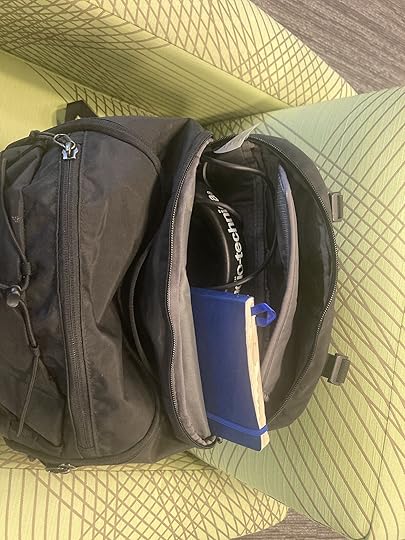 Photo: Tim Wenger
Photo: Tim Wenger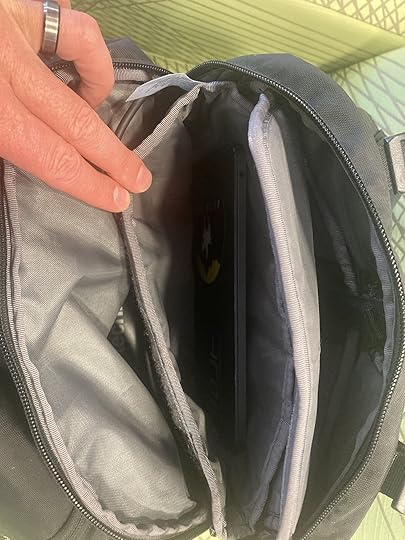 Photo: Tim Wenger
Photo: Tim WengerI’m not overstating the daypack’s importance even by an ounce. Think about it – as a remote worker, especially if you’re one who travels on the regular, you need enough space to bring your laptop and accouterments around with you, literally everywhere.
I almost always have a backpack on when I leave the house during the work day. Whether I’m headed to a coworking space, a coffee shop, or just up the street for a snack, I need my entire career to fit into that backpack. That includes a MacBook Pro, its charger, a pair of headphones, and a notebook. There must be enough room left over for gym clothes, lunch, and my e-bike charger (because I’m that guy who commutes via e-bike and then unabashedly tells you about it). On top of this, I need space for a few groceries or light items I may stop to grab at the store on the way home.
The Patagonia Refugio comes in two sizes – 26 liters and 30 liters (there’s also a kid’s Refugito version that can come in 12-liter or 18-liter sizing). I opted for the 30L option because I’ve consistently been frustrated by the lack of space available in every daypack I’ve used before this one. I don’t always fill up all 30 liters, but I’d rather have extra space than not enough. Both sides of the pack have cupholders, making it possible to bring both a water bottle and a coffee thermos with me at all times. Heck, depending on the day, you may even spot me with a bottle of wine in one of the holders (I do live in Palisade, after all).
Bringing this daypack along as a carry-on is no problem on all major airlines globally. It will fit underneath the seat in front of you and fits in the overhead bin space even if you’re in a later boarding group that pits you in a tight race for the last remaining corners of bin space. You can choose from a variety of color schemes for the Patagonia Refugito, but I went with good ole’ black. It blends in nicely wherever I am.
The Patagonia Refugio is perfect for the non-traditional lifestyle of remote workers Photo: Tim Wenger
Photo: Tim Wenger Photo: Tim Wenger
Photo: Tim WengerEven despite its large carrying capacity, the 30L Refugio looks no bigger than a typical backpack. It offers a 19-inch torso length with straps designed to comfortably fit a variety of body sizes. Tighten the back straps to carry the weight on the shoulders, or loosen them and clip the buckle around the waist for more even weight distribution. The pack even comes with a bike light clip at its base, allowing me to feel more comfortable commuting by e-bike even if I may not return home until dusk or later.
The pack is divided into three compartments. What I call the “tech compartment” is at the back and is headlined by a padded 15-inch laptop sleeve, big enough to fit most modern laptops. A velcro-strap top folds over the laptop sleeve to prevent the computer from sliding out. Also in this compartment are two open holsters that can fit stuff like a small notebook or passport, and a larger zippered pouch where I keep my laptop charger. There’s also plenty of open space where I keep my headphones and anything else work-related.

Photo: Alisha Wenger
In the second, and largest, compartment, which comprises the bulk of the 30 liters, I am able to fit a reusable lunch container, my bulky e-bike charger, a jacket, gym clothes, and any other items I have with me that day. Even on the few occasions I’ve filled it to the brim (like when I stuff a bike helmet in there), I’ve never had trouble zipping this pouch shut, which I greatly appreciate as this was a near-daily problem with my last daypack. The recycled polyester lining of the pouches is surprisingly easy to wipe down should any food spill, and on one occasion, I held the pack upside down and actually was able to dump food crumbs out of the bottom of the main compartment – a true blessing for a snack addict such as myself.
The small front compartment is ideal for a couple of liters worth of miscellanea. I keep napkins, a reusable grocery bag, reusable cutlery, and a phone charger in there at all times. All of this combines to provide enough space for everything one could need throughout even the most roller-coaster of days. Effectively, The Patagonia Refugio allows me to keep with me most of the stuff I’d have in a car were I to be a car commuter, which I view as a huge step forward not only for my quirky carrying habits but also for the growing percentage of society that prefers alternative methods of transportation.
The Patagonia Refugio upholds the brand’s sustainability ethos“. . . all fabrics are 100% recycled polyester except the stretchy mesh for the side pockets, which is an 84% recycled nylon/16% spandex blend.” This statistic put me over the top in my decision to acquire this daypack. I’d held on to my prior pack for several years even despite it’s increasingly ragged appearance, because, well, continuing to use something old is almost always more eco-friendly than buying something new. But when the time finally came to make a change, I felt good about opting for the Patagonia Refugito because I trust the brand to deliver a product that’s as sustainable as possible. There are many reasons why Patagonia topped a recent poll of brands with a stellar reputation. In addition to the fact that its products last nearly forever, come with a strong warranty, and can partake in the company’s robust refurbishing program, the fact that Patagonia is leading the charge in sustainably sourced clothing and outdoor goods is a big mark in its favor.
Patagonia Refugio specsTo simplify the sizing and carrying details for the Patagonia Regugio, here are the pack’s basic specs:
Capacity: 30 litersWeight: 1 pound 12 ouncesMaterials:Body: 7.3-oz 400-denier 100% postconsumer recycled polyester with a PU coating and a PFC-free DWR finishLining: 3-oz 200-denier 100% recycled polyester with a PU coatingBack panel and shoulder straps: 8-oz 100% recycled polyester spacer meshSide panels: 7.1-oz 84% recycled nylon/16% elastane power meshWebbing: 100% recycled nylonFeatures:Padded 15″ laptop sleeveBreathable back panel and hydration hangerTech-friendly features and organizationBike light clip19″ torso lengthIf you’re not sold, I encourage you to check out Matador’s reviews of Patagonia backpacks. Otherwise, grab a Refugio now before the rush. 
The State Once Called ‘Little Hollywood’ Celebrates 100 Years of Filming With Roadtrip-Ready Movie Locations

From Salt Lake City to Zion National Park, Moab to the Bonneville Salt Flats, Utah is one of America’s most cinematic states. It makes sense, then, that Utah has long served as a filming location for movies and TV shows — so much so that the city of Kanab once bore the nickname “Little Hollywood.” This year marks an impressive milestone for Utah’s connection to the screen: There’s a statewide celebration of Utah’s 100-year impact on film and television underway.
While movies have been shot in Utah since the 1920s, some of the first films to put the state on the cinematic map were Westerns like Butch Cassidy and the Sundance Kid starring Paul Newman and Robert Redford. In 1969, the same year that the film was released, Redford bought a 5,000-acre plot of land in Utah and opened the Sundance Mountain Resort, a nod to his titular role. A decade later, the Utah Film Commission launched what’s now known as the Sundance Film Festival to celebrate and market independent films, with Redford as chairman of the board. A couple of years later, the actor started the nonprofit Sundance Institute that now runs the festival, the largest independent film festival in the country.
In addition to celebrating a century of film and TV in Utah, 2024 also marks the 50th anniversary of the Utah Film Commission. Throughout the year, movie buffs will be able to attend a variety of film-centric events in Utah, from exhibitions to screenings. These events will honor classics shot in Utah, from early works like The Covered Wagon, to 1990s icons like Thelma & Louise and The Sandlot, to newer blockbusters like Mission: Impossible II and High School Musical.
TV fans also have their share of content to celebrate, with highly rated projects such as Westworld and Yellowstone using Utah as a backdrop.
That means that 2024 is an especially good year for a Utah road trip. Visit Utah has put together an exhaustive map of filming locations across the state, making it easy for movie buffs to chart an itinerary based around their favorite films and TV shows. If you’re more keen on touring the state while uncovering some big-screen Easter eggs along the way, here are two road trip ideas along the Utah Film Trail to get you started in your celebration of the state’s cinematic centennial.
Northern Utah and the Wasatch Mountains
Brought to you by Visit Utah
Northern Utah is home to both outdoor recreation areas and cities that play double duty as famous Utah destinations and popular filming locations. Start your road trip in Ogden where the first and second seasons of the TV series Yellowstone were shot downtown. Scenes from two memorable 1990s movies were also filmed in Ogden: You may recognize the Lorin Farr Community Pool from The Sandlot while Ogden High School and Kirt’s Family Drive-In in North Ogden both feature in Drive Me Crazy starring Melissa Joan Hart and Adrian Grenier.
From Ogden, drive south to Salt Lake City. Several films shot scenes here, including more of The Sandlot, all three High School Musical movies, the fourth and fifth installments of the Halloween franchise, the titular SLC Punk! (1998), Legally Blonde 2 (2003), and Midsommar (2019).
The rest of Salt Lake County and the formidable Wasatch Mountains east of Utah’s capital have featured in their share of movies and TV shows, too. For one, the Aspen mansion where Jim Carrey tracked down his love interest, Mary, in Dumb & Dumber was actually filmed at La Caille Restaurant in Sandy, Utah, near the Alta and Snowbird ski resorts. In winter, you can ski the same slopes as John Cusack’s character in the 1985 film Better Off Dead (1985) at Snowbird or head east to Brighton to see where the cabin in the 2014 adaptation of novelist Lois Lowry’s The Giver was set at the Silver Lake Summer Resort.

CSNafzger/Shutterstock
Once you’ve had your fill of the mountains, exit via the nearby cities of Payson, Lehi, and American Fork in Utah County to see where parts of the 1984 Footloose film were shot. You’ll pass by a few more filming locations as you head west toward the Bonneville Salt Flats, an otherworldly locale that’s hosted several film crews over the years. Make Skull Valley your first stop to see where Will Smith dragged an alien across the desert in Independence Day. Once you reach the Bonneville Salt Flats area, see how many films you can name with a familiar-looking setting. (Hint: The Tree of Life (2011), Pirates of the Caribbean: At World’s End (2007), and The World’s Fastest Indian (2005) starring Anthony Hopkins all shot scenes there).
To round out your film tour of Northern Utah, head to the city of Wendover on the Nevada border and stop by the Historic Wendover Airfield Museum. Once a training base for the World War II bomber that dropped the first wartime atomic bomb, Enola Gay, the airfield also featured in the 1997 cult classic Con Air and can also be spotted in scenes from Independence Day (1996) and Hulk (2003).
Notable stops: Ogden, Salt Lake City, Utah County, Bonneville Salt Flats, Wendover
Total distance: 272 miles
Total drive time: 4 hours
Brought to you by Visit Utah
Southern Utah has been contributing to movie magic for decades. Looking east, you’ll find settings that have featured in both blockbusters and Academy Awards winners and nominees. The southwest corner of the state, on the other hand, is the best place to visit in Utah if you’re charting a course around classic Westerns.
To see it all, start your road trip on I-70 near the Colorado border to see where parts of Thelma and Louise (1991) were shot. South of the interstate, around Moab and Arches National Park, you find more filming locations for Thelma and Louise and many other movies: Indiana Jones and the Last Crusade (1991), Austin Powers in Goldmember (2002), 127 Hours (2010), and Mission: Impossible II (2000) among them — the opening scene of Mission: Impossible II featuring Tom Cruise’s character free soloing a massive cliff was filmed at Dead Horse Point State Park.
Next, head south toward the Arizona border. In and around Monument Valley Navajo Tribal Park, you’ll see the desert road where Tom Cruise’s titular character in Forrest Gump (1994) abruptly stops his three-year cross-country run and where Johnny Depp and Armie Hammer filmed scenes for The Lone Ranger (2013). Deep dive into Visit Utah’s map to see what other movies, including Back to the Future Part III (1990) and National Lampoon’s Vacation (1983), also filmed in the area.

Zack Frank/Shutterstock
A few more filming locations skirt the Arizona border en route to Utah’s southwest corner, notably the iconic crash-landing site from Planet of the Apes (1969) at Lake Powell. From there, stop in Kanab (“Little Hollywood”) where both the Gunsmoke and Westworld TV shows set up film crews, as well as the team behind The Outlaw Josey Wales (1976). You can still visit what’s left of the historic Kanab Movie Fort film set dating back to the 1950s and swing by the Little Hollywood Movie Museum for Old West nostalgia while you’re in town.
Up next is one of the highlights of this itinerary: Zion National Park where Butch Cassidy and the Sundance Kid (1969) was filmed, as well as the Grafton ghost town. From there, St. George will be your final stop, with side trips to the surrounding cities and towns — what else to films like The Electric Horseman (1979), Romancing the Stone (1984), and High School Musical 2 (2007) have in common? If you’re a fan of the Disney franchise, play a round of golf at the Entrada at Snow Canyon Country Club, just like Troy Bolton did at the fictional Lava Spring Country Club in HSM2.
As an added attraction, stop by the Electric Theater in St. George. Founded in 1911, it was the first theater in Southern Utah dedicated to motion pictures — today, it hosts a variety of exhibits and performances, from art shows to music and comedy.
Notable stops: Moab, Arches National Park, Monument Valley Navajo Tribal Park, Lake Powell, Kanab, Zion National Park, St. George
Total distance: 576 miles
Total drive time: 17 hours 
The Best Hidden Bars in Dubrovnik

Dubrovnik has become one of Europe’s most popular cities. This is in part due to the fame from Game of Thrones and cruise ship footfall but also because of the medieval city’s stunning architecture of elegant limestone buildings, Gothic, Renaissance, and Baroque facades, and its network of narrow winding streets. The maze of ancient lanes takes you past small ice cream shops, boutiques, cafes, and hidden bars. Some of these drinking holes are so discrete you might find them hard to locate again — especially after a few negronis.
On a recent trip to Croatia, Michael Motamedi enlisted the help of GuideGeek, Matador Network’s personal AI travel assistant, to help hime find some of the best bars in Dubrovnik. Here’s how Motamedi and GuideGeek got on.
This is not the first time Motamedi has used GuideGeek to help with trip planning. For six months, the chef-turned-travel influencer let the AI travel assistant plan his travels with his family.
Using WhatsApp (GuideGeek’s free service uses ChatGPT technology and can be queried via WhatsApp, Instagram, and other messaging platforms in over 40 languages), Motamedi’s first stop was Buza Bar.
Traveling to Croatia? Check out Matador’s Croatia accommodations guides: The Finest Hotels in Dubrovnik With Spectacular Views Over the Adriatic Sea 9 Dreamy Airbnbs in Dubrovnik, Croatia, That Are Perfect for SummerThe Most Charming Airbnbs in Zagreb’s City Center
I’ve been to Buza Bar, and it’s not your typical polished city establishment. Buza Bar, which translates to “hole” in Croatian, is tucked into the city’s outer walls. Finding this bar is half the adventure. You need to look for an inconspicuous opening, marked by a sign that reads “Cold Drinks,” high up on the city walls. Step through, and you’ll be transported onto the cliffside overlooking the Adriatic Sea. Aim to visit at the end of the day a sunsets here are extraordinary.
Next, GuideGeek suggested the wine bar D’Vino Wine Bar, another favorite of mine. I was introduced to it by my expat friend, who lives in Croatia. I was told not to let anyone else know about this place, but GuideGeek clearly didn’t get that memo.
View this post on InstagramA post shared by D'vino Wine Bar Dubrovnik (@dvinowinebardubrovnik)
D’Vino has an impressive selection of Croatian and international wines, available by glass, bottle, or tasting flight. The staff here are the real draw. Even if you are new to wine or, like me, love nothing more than talking someone’s ear off about varietals and viticulture, you’ll have a blast here.
The final stop on Motamedi’s tour was The BAR by Azur, the place for cocktail lovers. While Motamedi wrapped up his hidden bar tour here in the afternoon, it’s also a great late-night hang.
View this post on InstagramA post shared by The BAR by Azur (@thebarbyazur)
There’s often live music and the bar tenders are well seasoned — if you don’t know your aviation from your boulevardier, you’ll be in good hands. 
15 Airbnbs in Sayulita to Experience Mexico’s Most Underrated Beach Town

Framed by the Sierra Madre Occidental mountains, Sayulita is one of the leading surf destinations in Mexico. The modest town is awash with art galleries, cute cafes, and yoga centers while this joyful seaside resort has a low-key yet fabulous nightlife if you’re looking to let your hair down. But first, where to stay in Sayulita? Cast an eye over our pick of the dreamiest Airbnb Sayulita vacation rentals that put you on the beach or up in the canopy.
Sayulita beachfront Airbnb rentalsSayulita Airbnbs with a private poolBeautiful Sayulita Airbnb treehousesWe hope you love the Airbnb Sayulita vacation rentals we recommend! Just so you know, Matador may collect a small commission from the links on this page if you decide to book a stay. Listed prices are accurate as of the time of publication.
Sayulita beachfront Airbnb rentalsBeachfront Airbnbs in Sayulita give you walk-up access to the best surfing, the best lounging, and the best coastal views. And because the town is right there, you can easily hop on a bike and be at the taco shop in moments.
Casa Paraiso: Unparalleled luxury villa Photo: Airbnb
Photo: Airbnb Photo: Airbnb
Photo: Airbnb Photo: Airbnb
Photo: Airbnb Photo: Airbnb
Photo: AirbnbSee more photos
This deluxe beachfront villa sits mere yards from the water and has the added convenience of a private pool with mountain views. Two of the guest rooms are equipped with al fresco showers while the fourth is rigged with bunks that’ll delight the little ones in your party. This Airbnb Sayulita is pet-friendly and comes with a cook included in the price who will prepare breakfast and lunch daily.
Eleven guests, four bedrooms
Price: $1,155 per night
 Photo: Airbnb
Photo: Airbnb Photo: Airbnb
Photo: Airbnb Photo: Airbnb
Photo: Airbnb Photo: Airbnb
Photo: AirbnbSee more photos
This cozy Airbnb in Sayulita is curated for couples and honeymooners. The bungalow overlooks the ocean and is decked out with a private spa tub on the balcony. A simple kitchen lets you prepare basic meals to enjoy on the terrace as the waves crash below. Elsewhere at the complex you can make use of the shared pool and ask the concierge to arrange chefs, massages, excursions, and golf cart rental.
Two guests, one bedroom
Price: $200 per night
 Photo: Airbnb
Photo: Airbnb Photo: Airbnb
Photo: Airbnb Photo: Airbnb
Photo: Airbnb Photo: Airbnb
Photo: AirbnbSee more photos
Casa Paloma was remodeled by the same architect who designed an estate for the President of Mexico. The ozone-treated pool is set within a landscaped botanical garden while the rooftop terrace grants 360-degree views. Each of the six bedrooms has a personal bathroom and either an ocean or jungle view. Maid service is included in the rental fee while chefs and spa treatments may be added via the host.
Twelve guests, six bedrooms
Price: $985 per night
 Photo: Airbnb
Photo: Airbnb Photo: Airbnb
Photo: Airbnb Photo: Airbnb
Photo: Airbnb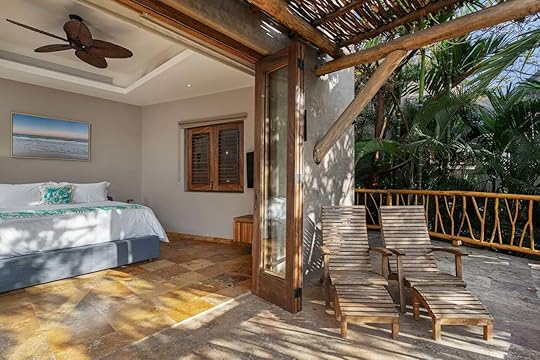 Photo: Airbnb
Photo: AirbnbSee more photosEach of the modern rooms at Casa Kocomo offers incredible sea views – and that’s before you take into consideration the air conditioning, high-speed internet, and HD satellite TV. Two of the king suites (yes, there are two) offer a unique touch with outdoor showers in a jungle-like setting, while all three king suites boast breathtaking ocean and pool views. A fourth room with bunk beds provides the perfect space for children or teenagers.
Unwind on the beautifully designed terrace, perfect for relaxation or recreation. There’s a dedicated local host to curate your Sayulita experience, as well as daily maid service and a chef who prepares daily breakfast and lunch (though you still have to pay for the groceries). In addition, you’ll have access to a gym, beach club access, and a golf cart to head into the city center, so no need for a rental car.
Eleven guests, four bedrooms
Price: $1,200 per night
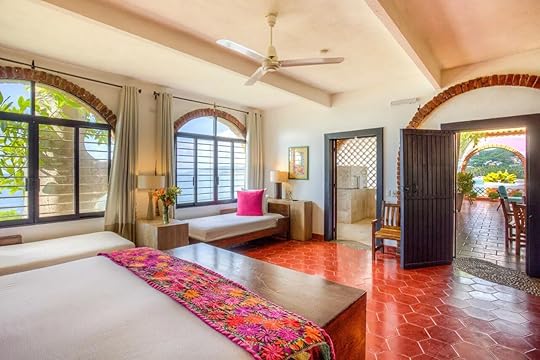 Photo: Airbnb
Photo: Airbnb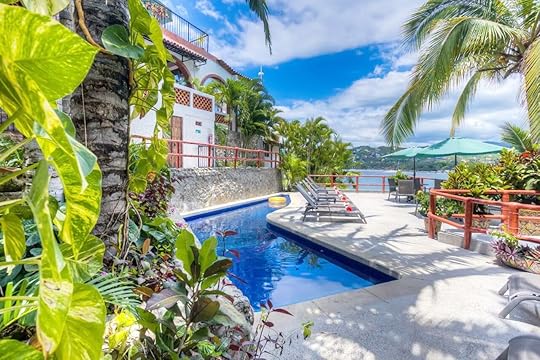 Photo: Airbnb
Photo: Airbnb Photo: Airbnb
Photo: Airbnb Photo: Airbnb
Photo: AirbnbSee more photosThis Airbnb has a view of the bay and town from a private terrace. It’s a two-bedroom, two-bathroom bungalow with a fully-equipped kitchen and Wi-Fi. While that Wi-Fi is strong enough for streaming and downloading, it may not be suitable for digital nomads who are on video calls all day – though other work will be just fine. That said, this spot is great for small biz retreats and families. The location is a five-minute walk to downtown and you’ll have direct access to the beach — bring plenty of sunscreen. When chilling at the pad you can take advantage of the shared pool and terrace.
The bungalow has air-con and also offers a safe, hair dryers, and ironing setup. Limited parking is available on-site. Check with the host for info on a concierge to arrange transportation, nights out, groceries, and more services.
Eight guests, two bedrooms
Price: $450 per night
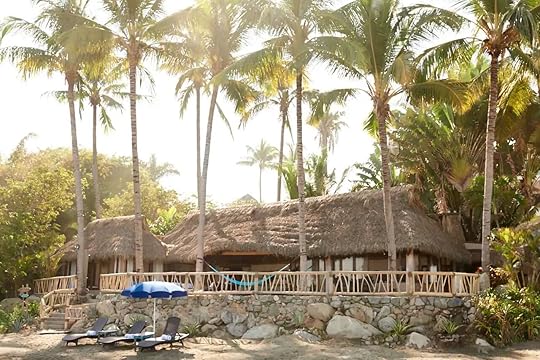 Photo: Airbnb
Photo: Airbnb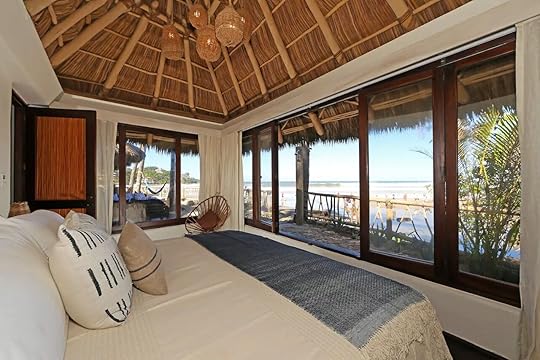 Photo: Airbnb
Photo: Airbnb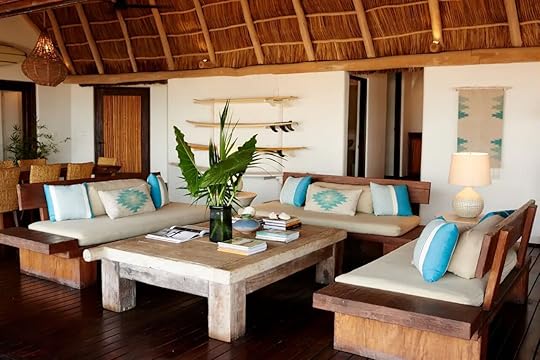 Photo: Airbnb
Photo: Airbnb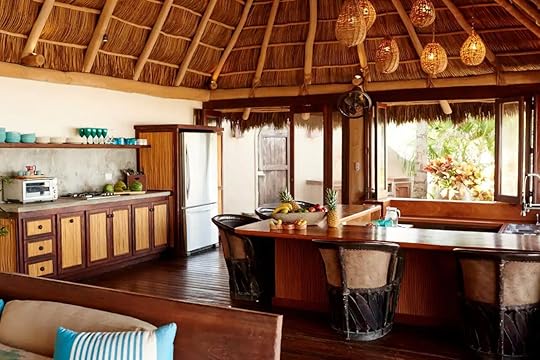 Photo: Airbnb
Photo: AirbnbSee more photosCasa Playa is a chic and luxurious bungalow that offers the best of both worlds: the sleek design of a hotel and the comforts of a home. This newly remodeled beachfront property boasts two bedrooms with ensuite bathrooms and king-sized beds, with the possibility of accommodating additional guests in a bonus third bedroom or on a pull-out sofa. The comfortable beach-chic decor is accented with traditional Mexican textiles and artwork, and most rooms offer stunning ocean and surf views.
Unwind in the media room with a 60-inch TV featuring Netflix, Apple TV, and satellite, or relax on the palm tree-shaded terrace with a hot tub, grill, hammock, and plenty of seating. The space seamlessly transitions into the living areas, making it ideal for socializing. Casa Playa also provides lounge chairs and umbrellas on the beach for your ultimate relaxation, and you can even arrange for room service delivery from Don Pedro’s Restaurant or take advantage of the daily maid service.
Six guests, three bedrooms
Price: $545 per night
 Photo: Airbnb
Photo: Airbnb Photo: Airbnb
Photo: Airbnb Photo: Airbnb
Photo: Airbnb Photo: Airbnb
Photo: AirbnbSee more photosImmerse yourself in Moroccan flair at this stunning villa boasting breathtaking ocean and coastline views. The unique décor features original art pieces and bursts of color, creating a truly eclectic atmosphere. This spacious retreat comfortably accommodates six guests with two king-bed ensuite bedrooms upstairs and another king-bed ensuite downstairs.
Unwind by the private pool, complete with a charming Bali Bungalow on the grassy platform – perfect for reading a book or soaking up the sun. Relax on a lounge chair under an umbrella, or fire up the barbecue on the downstairs terrace for an al fresco feast. The villa’s convenient location offers a short walk (5-8 minutes) to the town and local beaches. For those seeking a more secluded escape, Playa de Los Muertos and Carricitos are just a bit further away, offering hidden coves and natural pools. Explore the area at your own pace, or inquire about renting a car or golf cart for added convenience.
Six guests, two bedrooms
Price: $270 per night
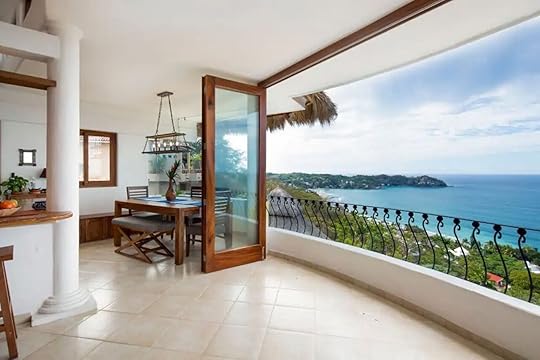 Photo: Airbnb
Photo: Airbnb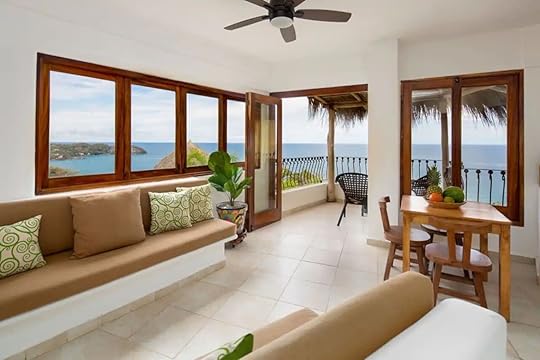 Photo: Airbnb
Photo: Airbnb Photo: Airbnb
Photo: Airbnb Photo: Airbnb
Photo: AirbnbSee more photosVilla Esperanza is a luxury vacation rental in the hills north of the city center. The ocean views are epic – as are the calming sounds of the surf. There’s a palace bar, which effectively means a large bar, onsite. As the sun sets, cozy up on the outdoor couch and witness a spectacular display of colors painting the Pacific sky. This private oasis promises an unforgettable vacation experience.
This two-story main house boasts a fully equipped kitchen, living area, and a master bedroom on the top floor along with two bedrooms with ensuite bathrooms downstairs. A separate casita offers additional space, featuring a one-bedroom apartment complete with its own kitchen, bathroom, laundry facilities, and a living area with a balcony overlooking Sayulita. For an unforgettable end to your day, head to the rooftop terrace with a bar and BBQ, the perfect spot to unwind and soak in the stunning sunsets. Be prepared for some uphill climbs as the villa is located on a hill, but the peaceful and secluded atmosphere makes it well worth the effort.
Eight guests, four bedrooms
Price: $350 per night
Taking a trip to Mexico? Check out Matador’s Mexico accommodations guides:The best Airbnbs in and around Mexico City’s historic center8 La Condesa Airbnbs to settle into Mexico City’s coolest neighborhood8 stunning Polanco Airbnbs in the city’s most international neighborhoodGrab Your Crew and Book These Oaxaca and CDMX Airbnbs for Dia de Los MuertosThese Top-Rated Tulum Airbnb Rentals Put You Right Near the Beach11 Cancún Airbnbs for an Unforgettable Beach Vacation11 Airbnbs In Cabo San Lucas for a Perfect Beach EscapeSayulita Airbnbs with a private pool
Don’t forget your swimsuit (not that you would on a trip here), because these Sayulita Airbnbs with a pool are the best places to chill in town. This is Sayulita coastal life, optimized.
Dreamy villa – Dulce Vida Photo: Airbnb
Photo: Airbnb Photo: Airbnb
Photo: Airbnb Photo: Airbnb
Photo: Airbnb Photo: Airbnb
Photo: AirbnbSee more photos
This custom-built property is spread over two floors with the roof terrace providing the perfect hangout for an evening sundowner. Spend lazy afternoons jumping into the saltwater pool and soaking up the rays on the patio. Interiors continue the theme with bold textures, shapes, and colors across the decor and furnishings. The pet-friendly Airbnb Sayulita is located in the heart of town.
Eight guests, three bedrooms
Price: $300 per night
 Photo: Airbnb
Photo: Airbnb Photo: Airbnb
Photo: Airbnb Photo: Airbnb
Photo: Airbnb Photo: Airbnb
Photo: AirbnbSee more photos
Soak up the silence from your private pool at this Sayulita Airbnb with only the sound of the birdsong in the background. No stone is left unturned in the attention to the materials, ornaments, and amenities at this mini-villa for couples. Prep light meals using ingredients from the market in the ornate kitchen and indulge in casual afternoons swaying in the hammock.
Two guests, one bedroom
Price: $175 per night
 Photo: Airbnb
Photo: Airbnb Photo: Airbnb
Photo: Airbnb Photo: Airbnb
Photo: Airbnb Photo: Airbnb
Photo: AirbnbSee more photos
This family-friendly Airbnb in Sayulita is a casita centrally located and designed with all the charm of a traditional Mexican home. Four roomy guest suites are flattered by three attractive bathrooms and homely communal space. The kitchen is well-stocked with modern amenities including a coffee machine and a juice blender so you can fashion your own margaritas to sip around the pool.
Eight guests, four bedrooms
Price: $440 per night
Sayulita is the perfect place for a treehouse Airbnb vacation rental. With lush forestry just off the coast, you’ll have the best of both relaxation and views from these properties.
Beachfront treehouse perched in the jungle Photo: Airbnb
Photo: Airbnb Photo: Airbnb
Photo: Airbnb Photo: Airbnb
Photo: Airbnb Photo: Airbnb
Photo: AirbnbSee more photos
Casa Nido is set within a patch of jungle and tropical garden overlooking the Sayulita coastline. The main dwelling is spread over three bedrooms each with a private bathroom while the detached palapa house has a further two rooms. Balconies are sheltered from the sun and provide perfect conditions for morning coffee or afternoon sun salutations. This pet-friendly Airbnb Sayulita suits couples, families, and larger groups.
Twelve guests, five bedrooms
Price: $590 per night
 Photo: Airbnb
Photo: Airbnb Photo: Airbnb
Photo: Airbnb Photo: Airbnb
Photo: AirbnbSee more photos
Nourish your soul at this unique Airbnb treehouse in Sayulita, buried in the foliage a 15-minute walk from downtown. You’ve got a decent kitchenette on the ground floor while the bedroom and an ornate bathroom occupy the upper floor and put you in direct line with the birds. The host will provide complimentary breakfast for your first morning and remains on hand to help with transport needs or tourist advice.
Three guests, one bedroom
Price: $75 per night
 Photo: Airbnb
Photo: Airbnb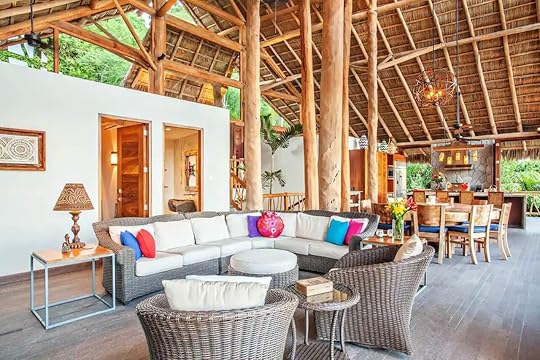 Photo: Airbnb
Photo: Airbnb Photo: Airbnb
Photo: Airbnb Photo: Airbnb
Photo: AirbnbSee more photosThis unique treehouse design boasts a spectacular palapa covering the living area, complete with a fully equipped kitchen, a beautiful dining table, and a cozy living space. The infinity pool seamlessly extends the living area, offering a panoramic vista of Sayulita Bay. With four bedrooms, this property is perfect for families and large groups, as its big (and the views are incredible – the kiddos will be in awe).
The expansive indoor/outdoor living room allows you to take in the stunning scenery of Playa Los Muertos beach, Sayulita town, and the entire coastline stretching north. Three air-conditioned bedrooms with ensuite bathrooms are situated below the main living area, offering private balconies with sweeping bay views. The master suite features a king bed and a luxurious bathroom, while the guest suites offer a king bed and a queen bed, respectively. Upstairs, an additional bedroom with bunk beds and a bathroom provide extra sleeping arrangements. As part of the Punta Sayulita community, this property offers 24-hour security and access to a spectacular beach club with a private beach, dock, pools, gym, TV room, and restaurant/bar. Guests can also enjoy complimentary use of paddle boards, surfboards, and kayaks for exploring the beautiful Sayulita Bay.
Eight guests, four bedrooms
Price: $1,400 per night
 Photo: Airbnb
Photo: Airbnb Photo: Airbnb
Photo: Airbnb Photo: Airbnb
Photo: Airbnb Photo: Airbnb
Photo: AirbnbSee more photos
Be the envy of all your friends (and followers) when you spend a night at this luxury Airbnb Sayulita treehouse. The property towers above the bay and delivers ocean vistas that’ll stay with you long after checkout. An open concept kitchen means you can cook with a view while the infinity pool elevates this gorgeous home to the next level. Situated within a premier housing development, you’ll have access to communal pools, a gym, a private beach, and watercraft rentals.

Eight guests, four bedrooms
Price: $1,400 per night
May 20, 2024
Hotel ÉPi 1959 Showcases the French Riviera’s Style, Sun, and Cuisine
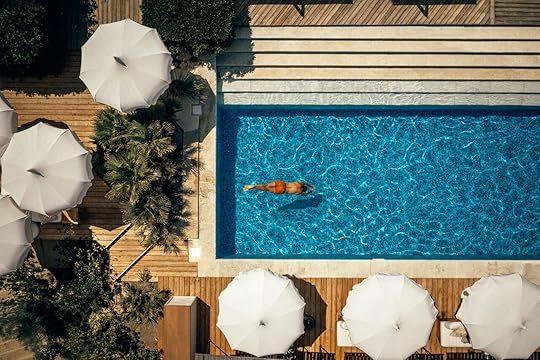
1959. Alaska and Hawaii received statehood, the Barbie doll debuted at the New York Toy Fair, and the arrival of Épi Plage caused ripples among the French Riviera jet set.
Inches from the sun-soaked shores of Pampelonne Bay (Brigitte Bardot’s favorite beach), the opening of this five-star boutique club and hotel was received with starry success during the golden 1960s. Épi Plage was masterminded by the nightclub magnate Jean Castel who, having conquered Parisian nightlife, turned his eye to the boom in Saint-Tropez tourism. Johnny Halladay spent the night, Audrey Hepburn was a fan.
Traveling to France? Check out Matador’s France accommodations guides: 9 dreamiest Airbnbs in the South of France The Most Stunning Airbnbs in Bordeaux For An Epic Wine Excursion The most beautiful Airbnbs in Paris These Airbnbs Near the Eiffel Tower Offer Incredible Views of the Entire City Elegant, Refined, and Luxurious Hotels in Bordeaux, France, the Wine Capital of the World These Airbnbs in Marseille Are Some of the Finest in the French Riviera These Provence Airbnbs Showcase The French Alps and Coastline
2019. Sixty years later, luxury interior designer Monica Damonte and celebrated landscape architect Madison Cox were tasked with recapturing the mythology of ‘60s St Tropez for the modern adventurer. The rejuvenated and rebranded Hotel Épi 1959 is truly epic but there is one snag. With accommodation limited to just nine private bungalows, the resort is as exclusive as it is elegant.
We hope you love the Hotel Épi 1959! Just so you know, Matador may collect a small commission from the links on this page if you decide to book a stay. Listed prices are accurate as of the time of publication.
Vintage beach bungalows at Hotel Épi 1959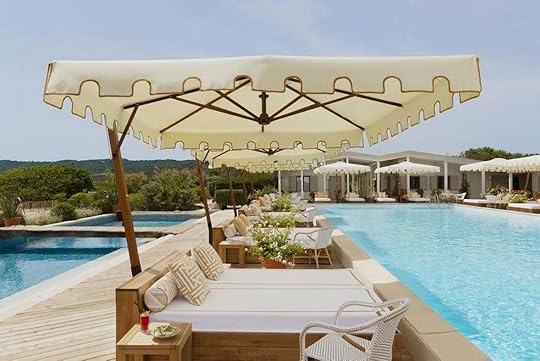 Photo: Vio.com
Photo: Vio.com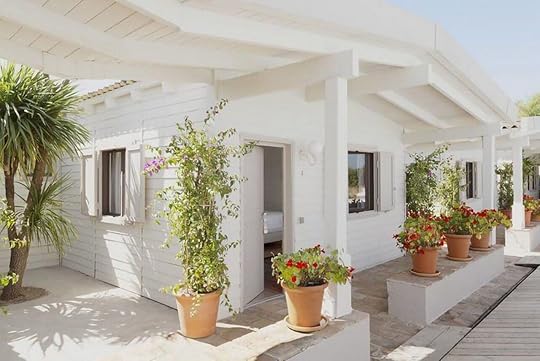 Photo: Vio.com
Photo: Vio.com Photo: Vio.com
Photo: Vio.com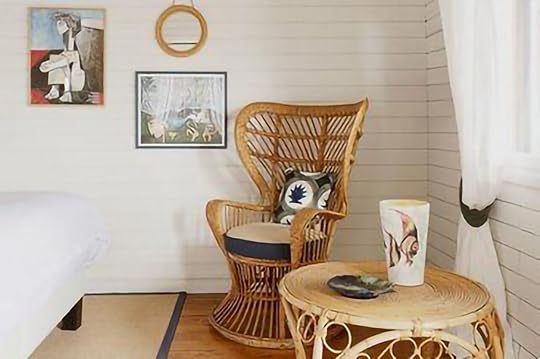 Photo: Vio.com
Photo: Vio.comBulking out this Mediterranean oasis in Ramatuelle with extra suites wasn’t part of the refurb. Only the original nine refuges remain, in an effort to preserve exclusivity and privacy.
Damonte styled these little cottages with a boujee-beachy-boho flair loyal to the free-spirited artists who shaped ‘60s Saint-Tropez. The exteriors are clad with white shiplap and each shack has a private patio and outdoor shower for washing off the sea salt. Each bungalow is outfitted with a king-size bed, rattan chairs, kitsch ceramics, and hand-picked art. Think, understated luxury that feels like home.
With only nine units up for grabs, you need to act fast to secure a stay. Save that sleep-in – or faire la grasse matinée as they call it in the Côte d’Azur – for your vacation.
Buffing and bronzing in Saint-TropezHotel Épi 1959 instills a holistic approach to health and wellness through its sports, pampering, and leisure facilities. Two sun-trap pools are edged by plush Balinese beds corresponding to each bungalow where you can while away a languid afternoon sipping rosé. Monica Damonte installed retro striped parasols to channel the Sixties essence (and keep the fierce Mediterranean rays at bay).
Stress-shredding yoga, pilates, and meditation classes are delivered on the sea-facing shala. No need to pack your gear – this is tricked out with high-end Manduka mats and props. The state of the art gym comes stocked with cardio, weights, and boxing bags and an attentive crew of fitness coaches.
Private tuition and casual play are available from sunrise until sunset in Épi’s heritage tennis court. John McEnroe gave this clay court his stamp of approval and it’s been part of the Épi club brand since the onset. Hotel guests also score complimentary access to the 18-hole course at Golf Club Saint-Tropez in Gassin.
Round off your summer sojourn with a treatment in the hotel’s premium spa. Skincare products are sourced from Biologique Recherche while massage oils and elixirs are supplied by Wesak Paris.
An epi-curean adventure on the French Riviera Photo: Hotel Epi 1959
Photo: Hotel Epi 1959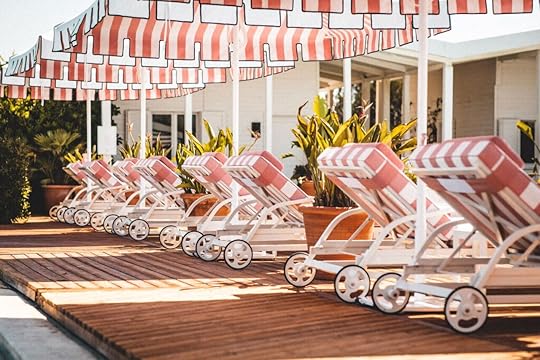 Photo: Hotel Epi 1959
Photo: Hotel Epi 1959 Photo: Hotel Epi 1959
Photo: Hotel Epi 1959 Photo: Hotel Epi 1959
Photo: Hotel Epi 1959Castel named his Saint-Tropez hotel in homage to the French épicerie, a late-night grocery store where famished Parisian revelers would seek to cure their drunchies. Dining at Épi aims to create that same sense of excitement and anticipation – but with a healthier slant.
It all starts with a posh petit déjeuner of pastries, fruit, and coffee served on the airy terrace or delivered to your patio. Chef Paolo Amadori is helming the 2024 season at the Club Restaurant with an Italian-French menu. Expect a selection of straight-off-the-boat shellfish and the tenderest of steaks doused in mother sauces. There’s an endless supply of Provençal rosé as well as pressed juices and smoothies.
The hotel front desk can help with reservations in Saint-Tropez and the surrounding villages.
Getting to Hotel ÉpiRamatuelle bridges the gap between the famous Bay of Pampelonne and the fashionable town center. The Port of Saint-Tropez is less than 10 minutes by car: close enough for drifting in and out yet offering a welcome respite from the relentless summer crowds.
Hotel Épi 1959 is 70 miles from Nice and 90 miles from Marseille. Sure, you can rent a car and drive from either airport – there’s free parking at the hotel. If you fancy making check-in part of the Épi Plage experience, chat with the concierge about arriving from the sea. 
This Cross-Country Road Trip Goes From Washington’s Poo Poo Point to Canada’s Pee Pee Island
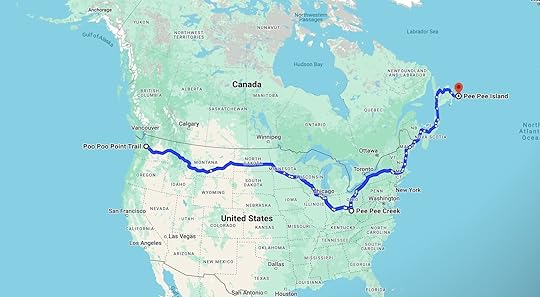
While some have lofty goals for their cross-country road trips, such as visiting as many national parks as possible, checking out world-class astronomical observatories, or even look for gems or fossils, others have more childish ambitions. The following cross-country road trip itinerary, from Poo poo Point in Washington, to Pee Pee Island in Newfoundland, Canada, is possibly the silliest of them all, but it’s guaranteed to take you through some fun place.
The road trip starts in Poo Poo Point, a view point near Issaquah, Washington, which can be reached via the Poo Poo Trail hiking path. The 7.2-mile hike is a popular one for the views of Lake Sammamish and the town of Issaquah that it provides. It’s also a launching point for paragliders. According to the Washington Trails Associations, the amusing name of the point has nothing to do with bowel movements, instead it “is a reference to the steam whistle sounds heard throughout the Tigers in the early days of logging.”
Next up on the list of humorous stops on this incredibly immature cross-country road trip itinerary is Pee Pee Creek in Pike County, Ohio. Pee Peek Creek is a stream that is said to have been named after an early settler whose initials were PP (Peter Patrick). Again, it’s got nothing to do with bodily functions. Unlike Poo Poo Point, however, Pee Pee Creek does not require you to hike to reach it. You can drive right up to it.
In 2020, a young man of the name of Ruben Lopez rode his bike for 36 days and over 2,500 miles from Poo Poo Point to Pee Pee Creek in an attempt to shed light on the suffering of the Yemeni people during the ongoing civil war which started in 2014.
I can’t believe I did it. Over 2500 miles on a bicycle, 36 days
LMFAO pic.twitter.com/gDGmiDUUTi
— Ruby (@rubydrummr) September 27, 2020
From Central Ohio, the itinerary takes you across the Canadian border to Pee Pee Island on the island Newfoundland (part of the province of Newfoundland and Labrador). The ride is nearly 2,300-mile-long and involves crossing part of New England and all three Canadian Maritime provinces: New Brunswick, Nova Scotia, and Prince Edward Island.
Pee Pee Island, formerly known as the much less funny Pebble Island, is a very small island that is part of the Witless Bay Seabird Ecological Reserve, North America’s largest Atlantic Puffin colony. You see can Pee Pee Island, as well as a multitude of sea birds and whales, by taking a tour with one of the licensed tour-boat companies located in the nearby towns. You cannot land on Pee Pee Island as it is a protected area that’s only for birds. The origin of the name Pee Pee Island are unknown.
If you want to extend your silly cross-country road trip a little further, after checking out Pee Island, hit the road towards the small town of Dildo, Newfoundland, a name whose origins . 
Giant Wildlife, Waterfalls, and a Canopy Walkway: 5 Epic Adventures in Guyana (Plus Where to Eat After)
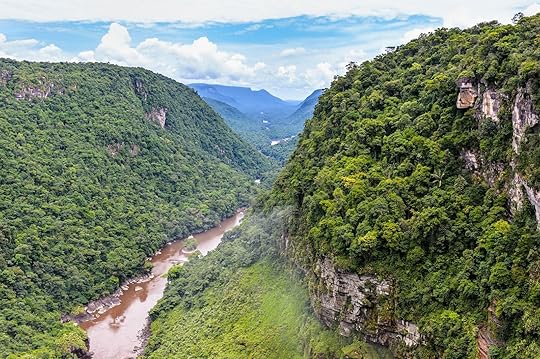
Guyana goes by many names. One of the only countries in the Caribbean Community that’s not located in the Caribbean Sea, Guyana is often referred to as the “Land of Many Waters” owing to the numerous rivers that flow through its perch on South America’s North Atlantic coast. It’s also called the “Land of Giants” — an abundance of water and minimal human interference have preserved Guyana as a fertile, untapped country where large flora and fauna thrive.
In Guyana, you’re also likely to hear the motto “one people, one nation, one destiny.” While Guyanese culture draws influences from an array of backgrounds — Indigenous, African, Caribbean, and Asian among them — this national motto reflects the country’s proud and collective spirit.
To me, Guyana is a home away from home, a place where I have family and have visited many times. Yet each visit brings new experiences, from rainforest explorations and wildlife encounters to delicious bites of Guyanese cuisine. Whether you’re visiting for the first time or returning to dig a little deeper, these are some of the must-do experiences that showcase Guyana’s beautiful outdoors and culture.
Outdoor and wildlife adventures in GuyanaKaieteur Falls
Merissa Baichulall/Shutterstock
A few years go, Guyanese-British Black Panther actress Letitia Wright posted a picture of herself in front of the most alluring waterfall I’ve ever seen. While I knew the photo was taken in Guyana, I struggled to conceptualize where in my home country this waterfall could possibly be located. Then, I visited Kaieteur National Park.
After taking a chartered flight from the interior to the landing of Kaieteur Falls, I was floored to realize that the mesmerizing attraction had eluded me for so long. After all, it’s the longest single-drop waterfall in the world, running an impressive 741 feet. Visitors to the national park where the waterfall is located will also be impressed by the native flora and fauna — various carnivorous plants, massive tank bromeliads, and a poisonous golden frog species included.
The park is committed to maintaining its ecological integrity. While everyone is welcome to admire the spectacle, my tour guide reminded my group of something that every traveler to Kaieteur Falls should remember — the only thing you can leave with are your memories.
Kaieteur Falls: Kaieteur National Park, Guyana
Caiman House Field Station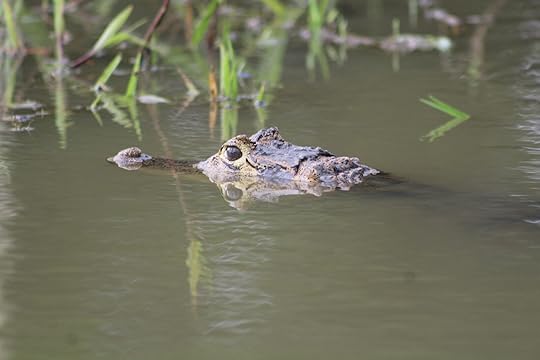
Ariel Miller52/Shutterstock
Most of us grow up learning about reptiles such as alligators and crocodiles. Fewer of us learn about caimans, the largest members of the alligator family. Native to the marshy lands of Central and South America, caimans are among the many animals that explain Guyana’s nickname as the “Land of Giants.” But even though I’ve visited Guyana many times, visiting the Caiman House Field Station was the first time I ever learned about and encountered the animal.
Since 2005, the Indigenous team at Caiman House has been conducting a field study on black caimans, the largest caiman species. To get to the Caiman House, my group took a 1.25-hour flight on a small plane to Guyana’s interior, then drove a few hours on a red dirt road to the Yupukari Village in the Central Rupununi. On arrival, we were escorted to a boat where we joined the team in finding a caiman. The team then transferred the animal to a sandbank where it was weighed, measured, sexed, and released back into its natural habitat.
For animal lovers, getting to participate in a tagging experience through the Caiman House is a special opportunity to connect with Guyana’s wildlife beneficially and responsibly.
Caiman House Field Station: MJ6W+FVJ, Yupukari, Guyana
Karanambu Lodge
Conor Phelan/Shutterstock
The last thing I expected to see in the middle of the Rupununi Savannah was an anteater stopping to strike a pose for our group before retreating to find a place to sleep for the morning. My group’s journey into the savannah started at 4:45 AM when we hopped in one of Karanambu Lodge’s pick-up trucks and headed for the grasslands. Our goal was to track down a horse-riding cowboy who was chasing a six-foot anteater that had just finished eating for the day. Like the caiman, the anteater is an animal that gives Guyana its “Land of Giants” nickname.
While seeing an anteater in its natural habitat was undoubtedly the star of this experience, being awake for the early morning sunrise stole some of the focus from the excursion (in the best way possible).
Karanambu Lodge: Yupukari, Guyana
Iwokrama Canopy Walkway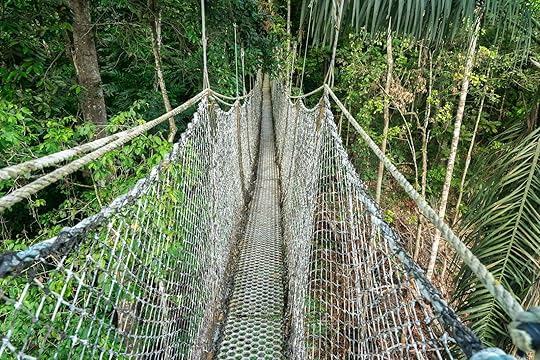
Gail Johnson/Shutterstock
Another experience requiring a pre-dawn wake-up call is the captivating Canopy Walkway located in the middle of the Iwokrama Forest. Along the walkway, my group learned about various tree species, including purpleheart and greenheart trees (which is said to be able to help stave off malaria). After following the trail and hiking a few stairs, we arrived at the Canopy Walkway as dozens of birds welcomed us with their distinct calls. Although we didn’t spot them during our visit, black spider monkeys and red howler monkeys also inhabit the forest.
Iwokrama Canopy Walkway: Iwokrama Forest Reserve Lethem to Georgetown Road Mauisparu, Guyana
Guianan cock-of-the-rock trek
Wang LiQiang/Shutterstock
It’s safe to say that I started this trip as a non-birder and ended it feeling as though I was at least an intermediate birder. Part of this is attributed to my group’s trek up a trail where we sat in silence for 20 minutes awaiting the famous Guianan cock-of-the-rock, a cotinga species that’s endemic to Guyana. The females of the unique bird species nest their eggs on the sides of large rocks while the bright orange males flaunt their colorful feathers through the trees of the forest. Visitors to Guyana are most likely to spot cocks-of-the-rock in lowland rainforest areas near the rock formations where they nest their eggs.
Where to eat and drink in GuyanaWaikin RanchView this post on InstagramA post shared by Waikin Ranch (@waikinranch)
Waikin Ranch is a farm and cattle ranch in Lethem that doubles as an excellent lunch spot. If you fly into the Lethem Airport, the ranch is roughly 30 minutes away by car. Covering 33,000 acres, Waikin epitomizes the farm-to-table ethos in its culinary offerings — 75 percent of the food you’ll enjoy comes directly from the family-owned farm. Waikin Ranch grows many of Guyana’s staple crops, including okra, plantain, callaloo (a leafy green), bora (a type of long bean), and pumpkin. The ranch is particularly famous for its crispy okra — with a well-balanced batter-to-okra ratio, the recipe avoids the questionable texture that puts some eaters off okra.
Waikin Ranch:Upper Takatu & Ireng River, Rupununi, Lethem, Guyana
Fresh RestaurantFresh is a more recent, modern-local restaurant in Guyana’s capital city, Georgetown, that’s co-owned by Michelle Howard. An Afro-Guyanese chef who recently re-migrated to Guyana, Howard uses local produce to blend traditional Guyanese flavors with a globally influenced twist.
Fresh Restaurant: RR9Q+P5M, Carmichael St, Georgetown, Guyana
Nigel’s Guinness BarGuyana’s coast is filled with numerous family-owned shops and street vendors who showcase the country’s most popular breakfast, lunch, and dinner cuisines. One of these street food options is Nigel’s Guiness Bar where you have the option to enjoy the beautiful warm climate with its outdoor seating. As a breakfast stop during your visit, a few of the must have meals include the bake and saltfish, boiled dumplings, ground provisions, and sweet plantains.
Nigel’s Guiness Bar: QVX5+XM4, Durban St, Georgetown, Guyana
Bourda MarketView this post on InstagramA post shared by Delven Adams (@backyardcafe.gy)
I’ve visited local markets in Georgetown for years, as my grandmother and I often travel from her village to pick up ingredients for that day’s meals. But on a market tour led by culinary master and chef Delven Adams allowed me to gain insights into the historical backgrounds and stories of the market sellers that I’d never experienced before. During the tour, you’ll taste local produce such as pineapple and papaya at various stands, encounter the holistic “bush” medicine stalls, and (if you’re lucky) taste a shot of the local rum, El Dorado — just be sure to carry a hat and water to get you through the journey under the hot morning sun.
Bourda Market: RR5R+WMH, Georgetown, Guyana
Backyard CafeView this post on InstagramA post shared by Delven Adams (@backyardcafe.gy)
My favorite part about coming back to Guyana is being able to stuff my face with the various spices, flavors, and ingredients of African, Indian, and Asian influence. After embarking on the aforementioned market tour, all of the fresh fruits, vegetables, meat, and seafood that we hand-selected were transported back to the Backyard Cafe’s kitchen for preparation, as Chef Delven curated the ultimate home-away-from-home atmosphere. When you visit, I recommend ordering the vegetable chow mein and shark. But, really, Chef Delven has a knack for everything — even ingredients that may be considered an acquired taste like karila (bitter melon) and farine (flour made from cassava) — into crowd favorites.
Backyard Cafe: QRVR+2G9, Georgetown, Guyana 
Paradisus by Meliá Is Injecting Culture and Fine Dining Into Their All-Inclusive Resort in Gran Canaria
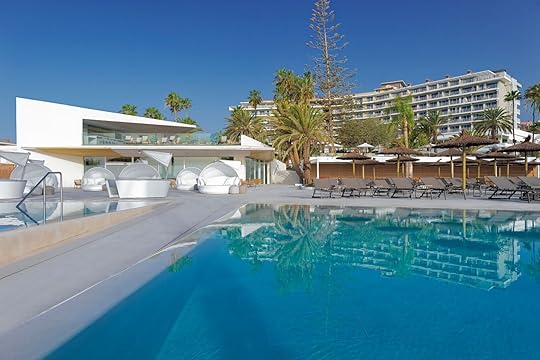
This was my first time visiting the Canary Islands. The archipelago off the coast of northwestern Africa is part of Spain and has long been a popular destination for Europeans looking for sunshine in Spring. The volcanic islands, which include Tenerife, Fuerteventura, Lanzarote, and Gran Canaria, have garnered the lazy reputation of being a place to flop and drop rather than explore. Although that’s not entirely fabricated, there are places and resorts that are shrugging off that reputation and working extremely hard to offer visitors a more immersive and cultural experience of the Canaries. One such property is the Paradisus by Meliá on Gran Canaria.
Local touches are present throughout the hotel. Paradisus, as a brand, champions the culture of each hotel’s destination. Nods to the Canary Islands can be seen in the food and drink offerings, resort-led excursions, on-site activities, hotel decor, and art exhibits that flow through the resort’s main building. Handmade woven light shades compliment carved wooden picture frames, and mini bars are stocked with rum from Gran Canaria, banana chips, and chocolate bars from the island.
The resort flows down to the beach with immaculately maintained gardens. Photo: Melia
Photo: Melia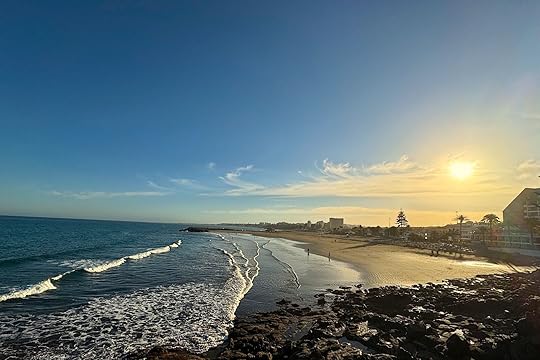 Playa de San Agustin at the foot of the resort on the quiet south coast. Photo: James Gavin
Playa de San Agustin at the foot of the resort on the quiet south coast. Photo: James Gavin Fisherman on the rocks and red rock crabs, a species native to tropical eastern Atlantic coasts, including Ascension Island, West Africa, and the Canary Islands. Photo: James Gavin
Fisherman on the rocks and red rock crabs, a species native to tropical eastern Atlantic coasts, including Ascension Island, West Africa, and the Canary Islands. Photo: James GavinThe expansive five-star resort is set on the south coast of Gran Canaria, on the Playa de San Agustín beach, just 20 minutes from the international airport. The resort can organize transfers, which, depending on the package you opt for, can be included in your all-inclusive fee.

The gardens and grounds are beautifully maintained.
Photo: James Gavin
Sprawling over impeccably kept grounds dotted with towering palm trees filled with parakeets, the resort’s grass areas, the indoor-outdoor spa with open air massage beds, restaurants, swimming pools, and accommodations are connected by winding paths.
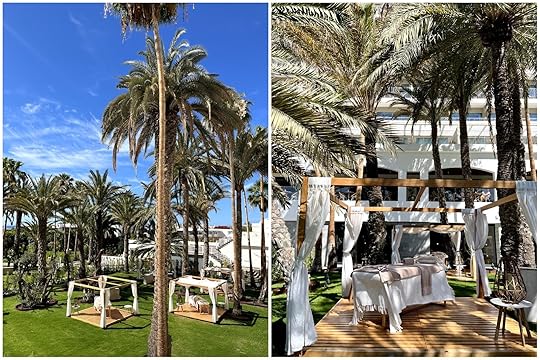
The outdoor massage beds are surrounded by swaying palms. An overhead canopy and curtains provide privacy.
Photo: Katie Scott Aiton
Playa de San Agustín, a relaxing and quieter alternative to the busier Playa del Inglés nearby, is accessible for guests by a secure gate at the bottom of the ocean-fronted resort.
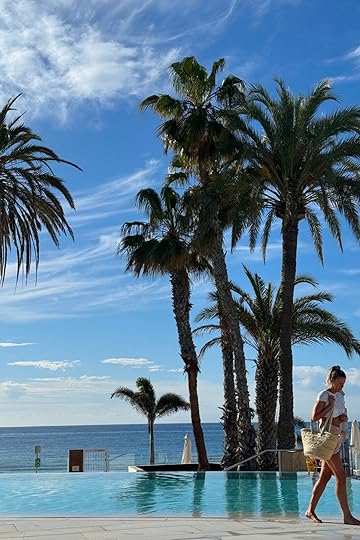
The main swimming pool.
Photo: James Gavin
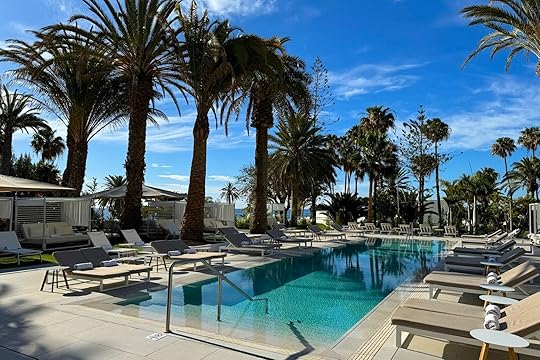 The Reserve area swimming pool is adults only. Photo: James Gavin
The Reserve area swimming pool is adults only. Photo: James Gavin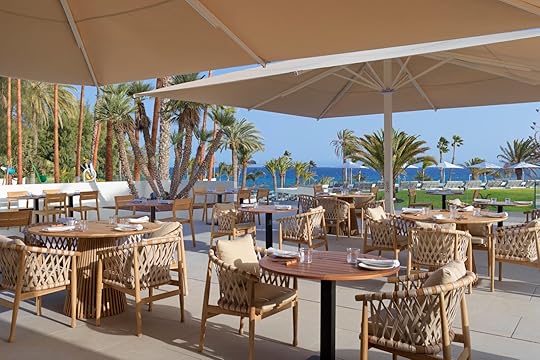 We enjoyed our breakfast in The Reserve area. Photo: Melia
We enjoyed our breakfast in The Reserve area. Photo: MeliaI stayed at the resort as a Reserve guest, an upgrade you can opt for to elevate your all-inclusive experience. It caters specifically to adults, with access to the Reserve area, which includes private check-in, a daytime bar and snack area, a plush lounge space, an adults-only pool (with bar service), a private breakfast dining space, and a 90-minute spa visit.
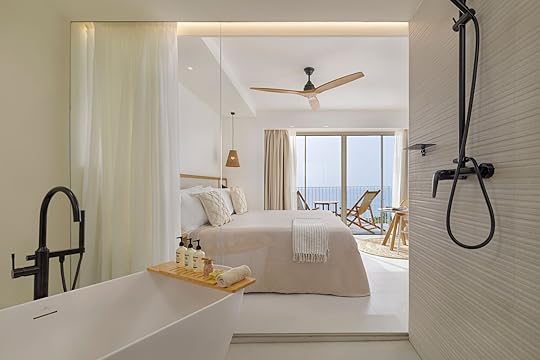 The Reserve Premium Room Ocean Front. Photo: Melia
The Reserve Premium Room Ocean Front. Photo: Melia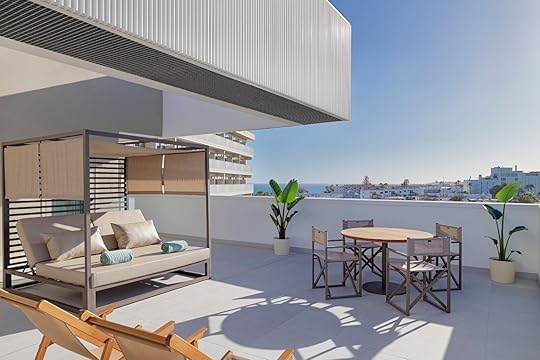 Outdoor sitting area of the suite. Photo: Melia
Outdoor sitting area of the suite. Photo: Melia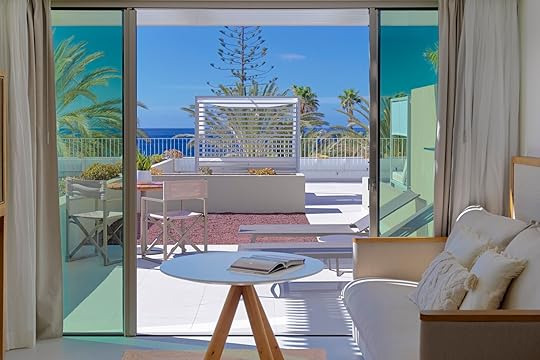 Photo: Melia
Photo: MeliaIt also grants you access to a selection of premium suites, with beautiful views over the garden and ocean, upgraded amenities such as balconies with hot tubs, and suites with patios and private cabanas. Rooms have a calming ambiance with a natural color pallet and use of soft natural materials. Our bathroom was glass-fronted (with a privacy curtain), so you could enjoy a soak in the bathtub with a view of the ocean in the distance. Luxury lemongrass-scented toiletries by Australian brand Biology are a lovely touch.
You can enjoy excursions and activities designed to connect you with the island’s culture, history, and natural beauty.Paradisus offers a twist on the traditional all-inclusive resort experience. As a Meliá Destination property, it goes beyond simply providing unlimited food and drinks. The resort offers a curated selection of excursions and activities designed to connect guests with the island’s culture, history, and natural beauty.
The resort is amenity and activity-rich, with something to do at seemingly every turn. The weekly entertainment schedule is jam-packed. Wellness and mindful offerings such as yin yoga, Pilates, and meditation are held in the garden in the shade of palms, aqua aerobics invites a mixed crowd of old and young to the main pool area, and watercolor painting, candle making, aloe workshops, and wine and cheese tasting in the resort’s winery introduce guests to the culture of Gran Canaria.
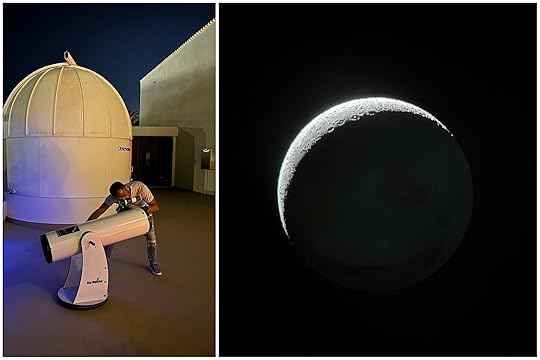
One of the highlights was the stargazing activity. Tickets for viewing are available on the event night from 9:00 PM. Luckily, we had a clear sky and were able to see the moon and many constellations through the telescope.
Photo: James Gavin
Kids are also well catered for. The Kidsdom schedule included three morning activities, two in the afternoon and one in the evening. The splash pad comes to life, there was a mini chef competition, educational workshops in the garden, an outdoor cinema, a pajama party, and a mini-disco.
On-site staff play a crucial role in facilitating these experiences. With the Reserve package, you’ll be introduced to your Destination Concierge upon arrival. They are local experts who can recommend excursions and create a personalized itinerary. This ensures you get the most out of your vacation to Gran Canaria; venturing beyond the resort walls, you’ll make meaningful connections with the island’s culture and people.
You can add as many excursions as you’d like to your stay. You can venture to Las Palmas to visit the Museum of Gran Canaria, spend the morning at a traditional Canarian rum distillery, where you’ll learn about the process of transforming locally grown sugarcane into the island’s iconic rum, or take a one-hour drive to Roque Nublo Natural Park and hike through the volcanic landscape to Roque Nublo, which gifts you breathtaking panoramic views of the island.
 Photo: James Gavin
Photo: James Gavin Photo: James Gavin
Photo: James Gavin Photo: James Gavin
Photo: James GavinWe toured a local working banana plantation, where we joined a knowledgeable guide who explained the lifecycle of banana plants, from cultivation to harvesting. The plantation is located in the north of the island, which has a dramatically different verdant topography compared to the south. The walking tour took us through rows of towering banana plants, where we learned about the different banana varieties grown in Gran Canaria and the sustainable practices passed down through generations. We finished our morning sampling some of the delicious banana products, from liqueur to marmalade.
Paradisus is successfully running a luxury all-inclusive.Food is where they could have faltered. But I was very pleasantly surprised. The quality of the products are to the highest standard. Menus are creative and varied, with dishes celebrating Canary Island food culture (as well as having a multitude of international options.)
“We want to give our guests the opportunity to experience the culture of Gran Canaria through the food we serve,” says the resort’s food and beverage manager, Raul Garate. Garate hails from Santander in the north of Spain and spoke to me about the passion the brand and team at Paradisus have for championing Gran Canaria.
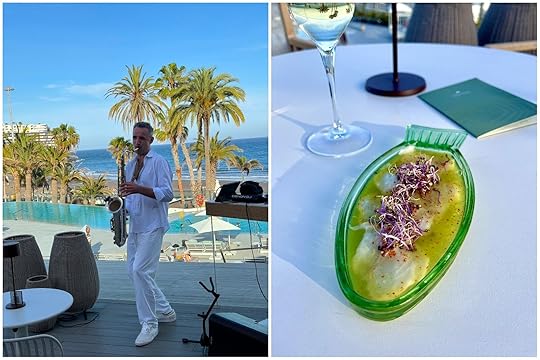 Lemon Fish restaurant specializes in ceviche. As the sun went down, we enjoyed live music and sea bass with fiery chili and jalapeno pepper dressing. Photo: James Gavin
Lemon Fish restaurant specializes in ceviche. As the sun went down, we enjoyed live music and sea bass with fiery chili and jalapeno pepper dressing. Photo: James Gavin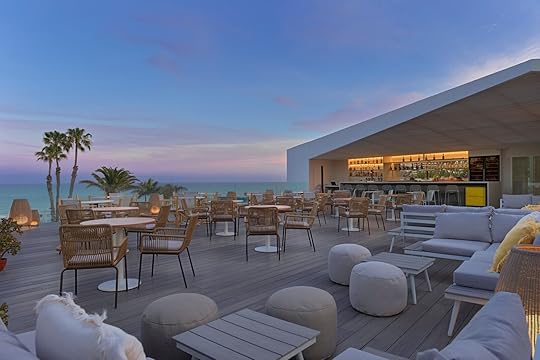 Lemon Fish as the sun sets. Photo: Melia
Lemon Fish as the sun sets. Photo: MeliaThere are eight restaurants peppered across the resort: Gastro Hall (the main dining area with a buffet), Ginger (the 24-hour bar and small-menu eatery), Vibra (the sports bar with a light bites menu), MasCalzone (the Italian trattoria-style restaurant), Peseta (with a tasting menu designed by Michelin-star chef Germán Ortega from Las Palmas in Gran Canaria), Kanna (the Mediterranean restaurant), Lemon Fish (the Peruvian kitchen where ceviche is a must), and The Shack (the relaxed pool bar).
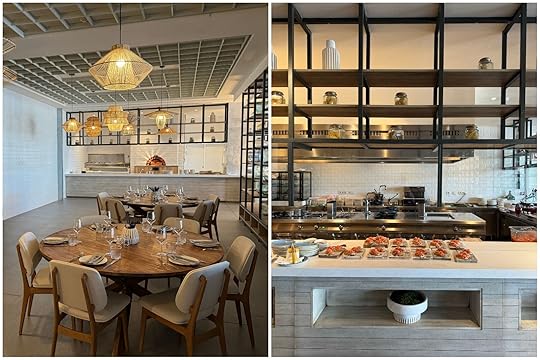
MasCalzone is Paradisus’ Italian restaurant. We enjoyed bruschetta with cherry tomatoes, stracciatella cheese, and anchovies, followed by a wood-fired pizza.
Photo: James Gavin
You can spend your entire vacation eating and drinking extremely well at Paradisus without spending anything extra. The options are endless; the house wines are local and delicious, and there’s a huge selection of cocktails and spirits. That said, at each restaurant, there’s an opportunity to upgrade your experience, whether that’s through the wine list (which leans heavily on bottles from the Canaries and Europe) or elevated sides such as jamón ibérico and lobster and fine-cut steak plates.
The Reserve package allows you to have breakfast in the VIP area. The a la carte menu offers a more formal setting than the morning buffet in the Gastro Hall. Spanish tortillas are a must here, as is the pancake stack with fresh redcurrants, cream, and chocolate.
I also enjoyed the Mediterranean restaurant Kanna. It’s situated on the lower pool level. The interior tables spill out through the open glass walls onto the patio and a cool breeze flows throughout (which is welcome if dining in the afternoon). I ordered well here. Plates of grilled and fried calamari and prawns with volcanic salt coupled with Mojo Roco sauce (a favorite dipping salsa in the Canaries of red peppers, garlic, and cumin) and homemade aioli became my mid-day go-to.

Tasting menu at Peseta.
Photo: Katie Scott Aiton
Michelin-star chef Germán Ortega is an advisor of the fine-dining restaurant Peseta. Each ingredient from the dishes originates within 60 miles of the resort. We had the choice of three menus of three courses (plant-based, fish, or meat) with a starter of homemade bread, whipped avocado butter with mint oil and alyssum flowers, olives from the south-eastern part of the island, and raw tuna cones with crunchy pea shoots. I opted for the Earth menu, starting with confit tomatoes from the garden with yogurt, followed by truffle and mushroom risotto and almond ice cream. In the future, Paradisus has plans to work with Ortega to design dishes for the other on-site restaurants. 
Matador Network's Blog
- Matador Network's profile
- 6 followers



